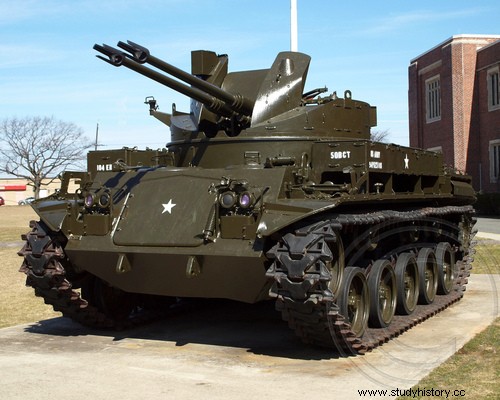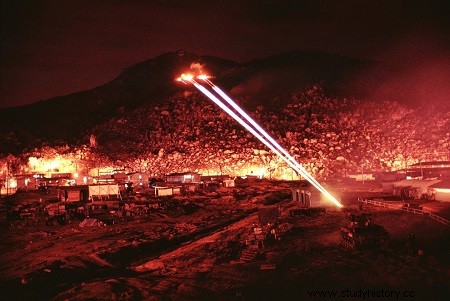
After the war. the American army only kept two self-propelled anti-aircraft guns. the M16 and the M19. But when the Korean War broke out in 1950, the industry almost immediately got down to the study of a new anti-aircraft self-propelled gun, designated T141, which employed many components of a new family of armored vehicles, which would eventually include the M14 light tank as well as the 55mm M44 and 105mm M52 self-propelled. Authorized in 1952, the production of the T141 was to continue until 1957. 11 was planned to succeed the T141. two other models:the T141E1, which would carry the artillery pieces, and the T53 which would carry the fire control. This program was cancelled, leaving the M42 in service.
The hull of the M42 (also known as the Duster) is all wrought steel ranging in thickness from 9mm to 25mm. The driver and the radio operator are installed at the front of the vehicle, the other members of the crew in the turret, located in the center of the hull. The rear houses the engine and transmission assembly. The M42's torsion bar suspension has five road wheels, a front idler wheel, a rear sprocket and three support rollers. The main armament consists of two twin 40 mm guns, in an open turret. The aiming control is assisted, the vertical firing sector goes from -3° to +85°, the horizontal firing sector covers the complete circle A manual control allows the negative elevation to be increased by 2°. The rate of fire for each tube is 120 rounds per minute. The total ammunition load is 480 rounds of 40 mm. Among the types of ammunition available are high and armour-piercing shells with tracers. When introduced into service, the M42 mounted a standard .30 M1919A4, with 1,750 rounds for close defense, but more recently this weapon has been replaced by a standard M60 7.62mm machine gun.
The M42 saw service in Vietnam in relatively high numbers, not in flak missions but to defend airbases and other vital objectives against Viet Cong infantry; the machine played this role very well thanks to its high rate of fire. However, the authorities very quickly understood the limitations of the M42 and several programs were started to improve the basic vehicle, but without result.

In the US Army, the M42 has almost entirely cleared in favor of the M163 or Vulcan anti-aircraft weapon system. This machine is a standard M113A1 troop carrier, mounting under a new electrically operated turret a six-tube Gatling-type cannon, produced by General Electric. capable of following a rate of either 1,000 or 3,000 strokes/min. However, the radar system with which this weapon is equipped can only be used in clear weather. Today. the army is testing a vehicle mounted on the old MeV XM701 chassis, a Philco Ford double 25 mm mount and a very elaborate fire control system. The Americans also tested the Gepard twin 35 mm anti-aircraft system and it is not excluded that this German machine is manufactured under license in the United States. The Rockwell company proposed to adapt to the chassis of the self-propelled M109 a redesigned turret that could house the General Electric 30 mm cannon as it arms the Fairchild Republic A-10 assault plane. The part would then be coupled to a pipe very advanced shooting technology. If realized, this device will be one of the most formidable anti-aircraft weapon systems ever developed Such an interest in anti-aircraft weapon systems is new to the US Army, which since the Korean War , intends to ensure the defense against aircraft of its units in the field with missiles such as the “Héwk”, the “Chaparral”, the “Nike-Hercules” and the “Redeye”. But it must be admitted that the Americans lost over North Vietnam many more planes under the blows of the anti-aircraft artillery than under the action of the missiles and this observation was only confirmed during the war. 1973 in the Middle East when the Syrian and Egyptian ZSU-23-4s inflicted heavy losses on the Israeli air force.
Type :Self-propelled anti-aircraft gun.
crew :6 men.
Armament :two twin 40 mm; a 7.62 mm machine gun.
Armour :at least 9 mm; max 25mm.
Dimensions:
length (barrel included):6.356 m:
length (hull):5.819 m;
beam: 3.225 m:
height: .847m
Weight in combat order :22.45 t.
ground pressure :0.65 kg/cm2.
Engine :Continental (or Lycoming) 6 cyl. air-cooled gasoline engine, developing 500 hp at 2,800 rpm.
performance
:
road speed :72 km/h;
autonomy :61 km;
vertical obstacle :Q711 m :
clean cut :.828 m;
slope :60%.
service time :introduced in the American army in 953. In service in Germany, Austria, Japan Jordan, Lebanon, Vietnam (probably not operational) and some examples remain in the American army.
